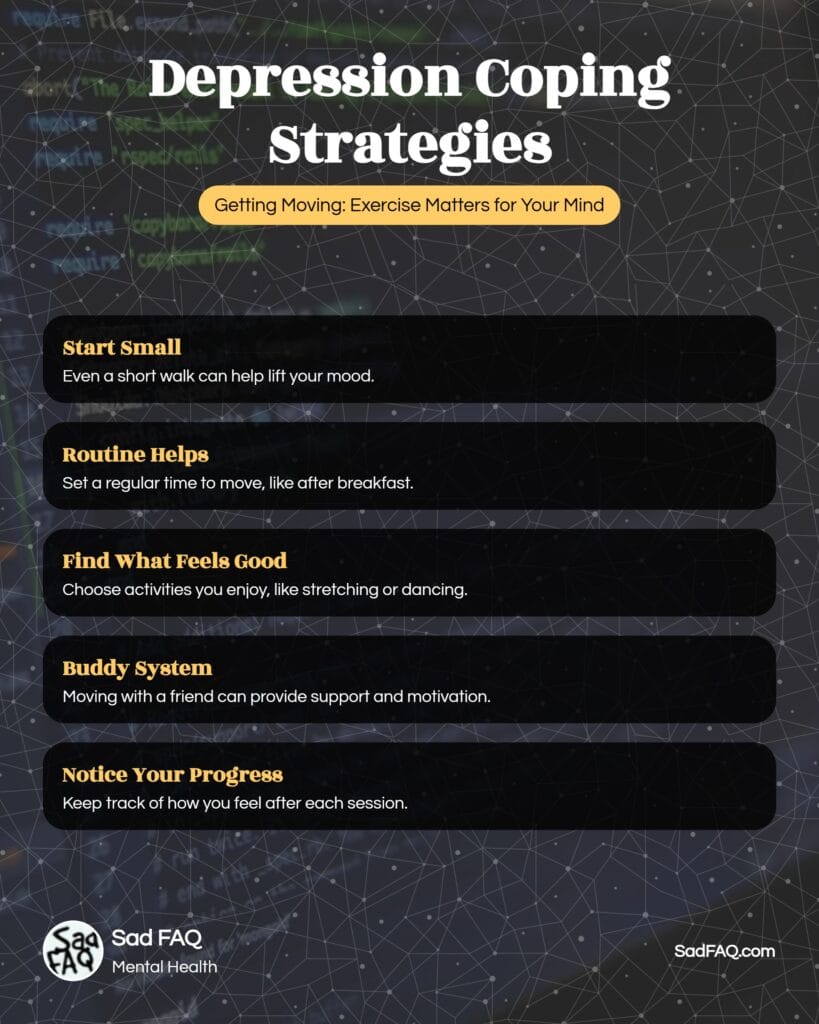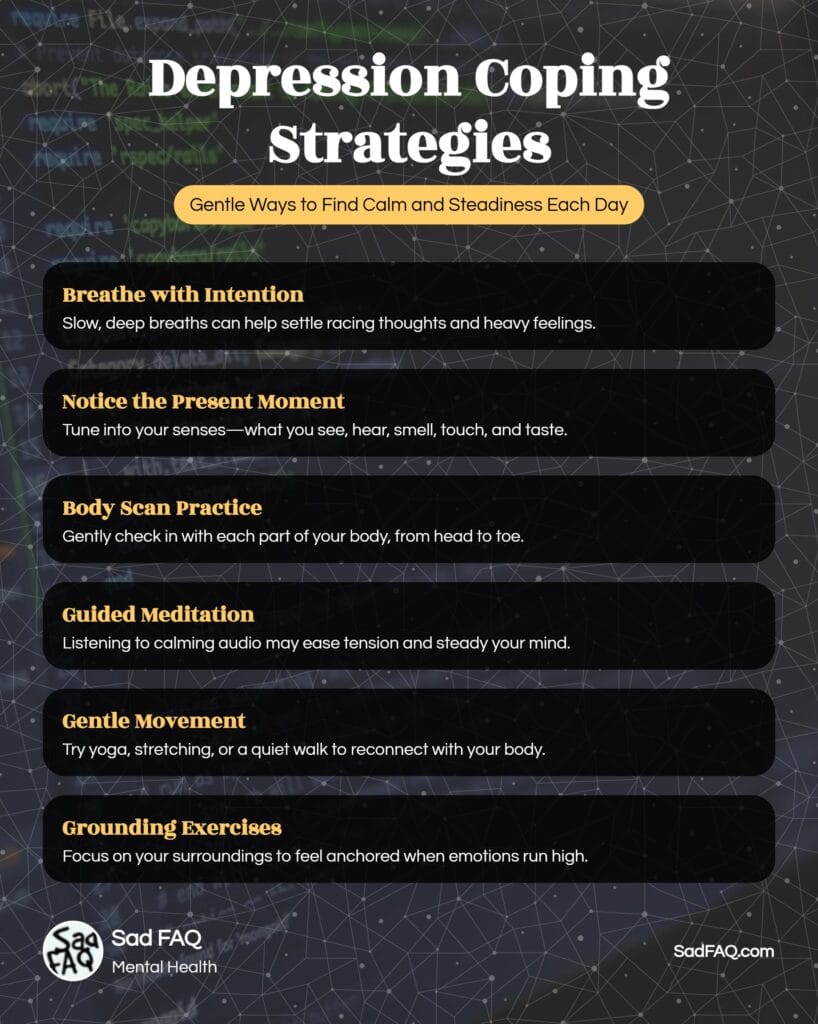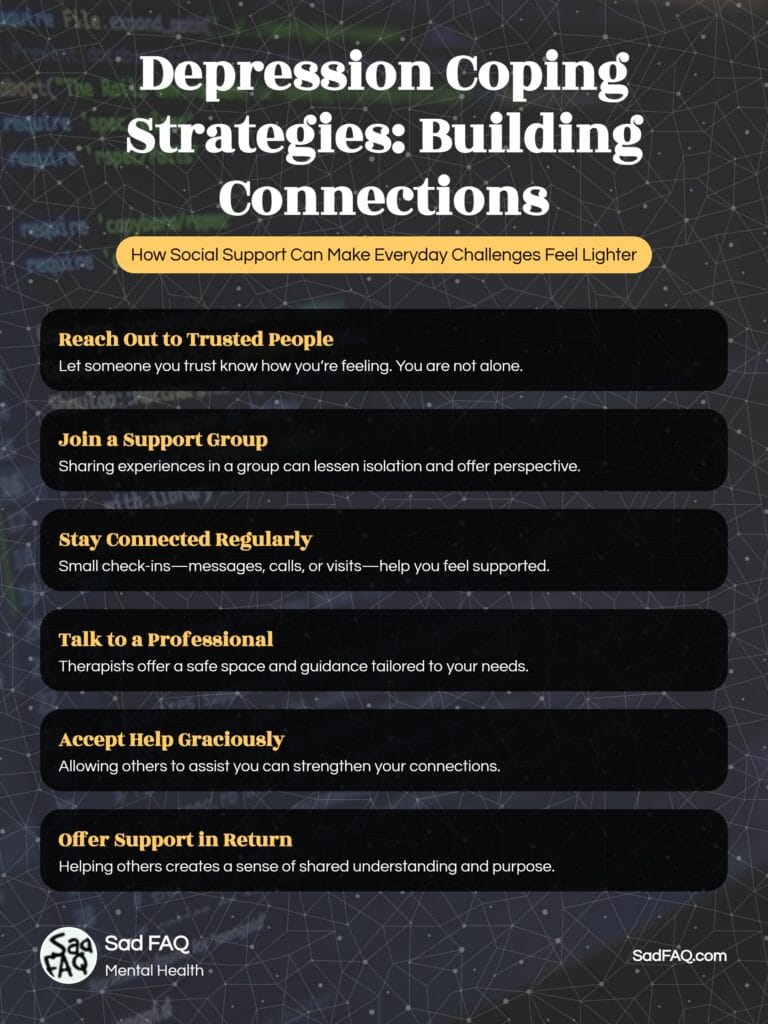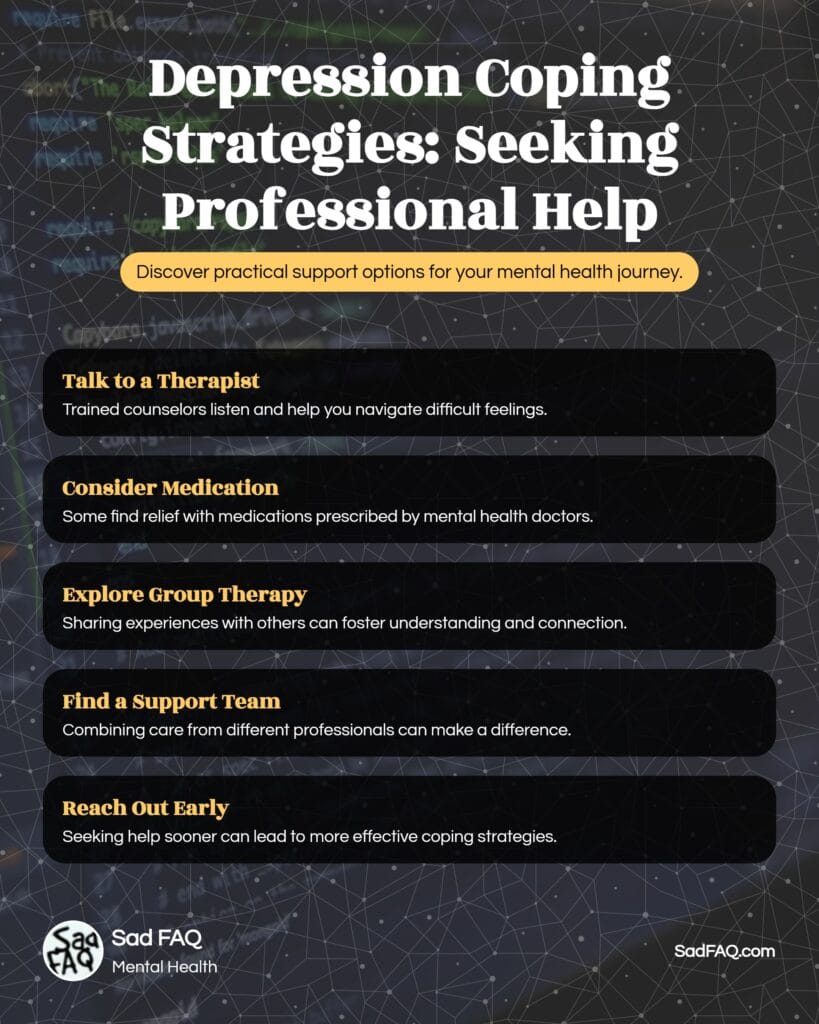Please Note: This post may contain affiliate links. If you click one of them, we may receive a commission at no extra cost to you. As an Amazon Associate, I earn from qualifying purchases.
Let’s be honest: sometimes life feels like you’re locked in a lousy reality show that never ends. You know the one: full of drama, surprises, and too many unhappy faces. If you’ve ever felt that a heavy cloud of depression was hanging over you, believe me, you’re not alone. But don’t worry! There are a lot of ways to deal with things that can make your day better and help you get through tough times.
Top Takeaways and Key Concepts
- Acknowledge Your Emotions: Pause daily to identify and write down your feelings.
- Create a Routine: Start small habits like consistent wake-up times and breakfast.
- Move Your Body: Walk, dance, or laugh to release endorphins and boost mood.
- Practice Mindfulness: Use deep breathing, meditation, or visualization for stress relief.
- Build Connections: Spend time with friends, family, or pets for emotional support.
This guide emphasizes practical ways to manage depression through self-awareness, routines, movement, mindfulness, and social support. Understanding and acknowledging emotions, whether by journaling or observing daily patterns, helps clarify what’s troubling you. Establishing small, consistent routines and incorporating enjoyable movement activities, like walking or dancing, releases mood-boosting chemicals. Mindfulness and relaxation techniques, including deep breathing, naps, and laughter, offer mental clarity and stress reduction. Finally, connecting with friends, family, or pets provides comfort, humor, and emotional stability, while professional therapy or creative outlets like art therapy can provide tailored support. Overall, these strategies build resilience and help cultivate hope during tough times.
Understanding Your Feelings

Sometimes, people use food as a coping strategy for depression, but did you know that in Japan, there’s a phenomenon called “Shinrin-yoku,” or “forest bathing”? It involves immersing yourself in nature to boost mood and reduce stress. So, while some might reach for ice cream during tough times, others are hugging trees—literally!
“Feelings are just visitors. Let them come and go.” — Mooji
It’s crucial to recognize what you’re experiencing before you start thinking about how to deal with it. Have you ever thought about why some days seem heavier than others? We can get so busy with our daily lives that we forget to check in with ourselves. It’s not just a phase when you feel low or concerned; it’s your mind’s method of telling you that something requires your attention.
There was a point when I felt like I was hauling around an invisible rucksack full of bricks. It really wore me out! Every day felt heavier than the one before it, and every time I tried to cheer myself up, I could almost hear those figurative bricks banging together. Isn’t it funny how life can feel like a never-ending uphill battle? When you wake up in the morning, you don’t feel rejuvenated and ready to take on the world. Instead, you feel like you just ran a marathon while juggling blazing torches. Not how most people like to start their day!
Feelings 101: Understanding Your Emotions
– Brain Freeze for the Soul: Did you know that when you’re feeling sad, your brain can actually feel colder? Studies show that emotional pain can trigger the same brain areas as physical pain. So, yes, heartbreak might make you feel like you’ve just chugged a slushy too fast!
– Mood Food: Eating chocolate may not solve all your problems, but it can help! Dark chocolate contains chemicals that boost serotonin and endorphins—basically happiness in a wrapper. Just remember, moderation is key unless you want to turn into a chocolate bar yourself.
– Laughter Really Is Medicine: Ever notice how laughing makes you feel better? That’s because laughter releases endorphins, which are like tiny joy ninjas in your brain. So next time you’re down, find a funny cat video—your mood will thank you!
So, taking a moment to pause and understand your feelings is crucial. You might think that ignoring them will make them go away—like hiding under the covers hoping that the monsters will just vanish. But trust me on this one; that strategy rarely works out well! Instead of letting emotions fester like leftover pizza in your fridge (and we all know how quickly that can get gross), try acknowledging what you’re going through.
Writing them down can be incredibly helpful! Journaling is like having a heart-to-heart with yourself without any judgment or interruptions. When you put pen to paper—or fingers to keyboard—you give those swirling thoughts an outlet. It’s as if you’re throwing confetti at a party—except this confetti is more gray than colorful. You know what I mean: it’s messy, overwhelming, and often hard to deal with! By writing about your feelings, you’re giving each piece of gray confetti its moment in the spotlight instead of allowing them to drift aimlessly around your mind.

When you start writing, you can find that words flow out like Coke from a shaken-up can—unexpected but nice! What began as random notes about feeling bad can turn into deeper thoughts about what’s actually upsetting you. It could be work stress or problems in your relationships that you haven’t dealt with yet. Either way, talking about them helps clear things out. And let’s be honest: reading what you’ve written again might seem like finding an old diary full of secrets you forgot you had. It can be really eye-opening!
When you write every day, you’ll start to see patterns in how you think and feel. This method not only helps you let go of your feelings, but it also gives you a time to think about yourself and where you’ve been and where you want to go next. It’s like being the main character and the author of your own novel at the same time! So get out your journal or open a blank page on your computer. You never know what new ideas will come to you after the first few lines.
Establishing a Routine

Establishing a routine can be a game changer for managing depression, but did you know that some people have taken it to the next level? In Switzerland, there’s a tradition called “Morgenstund hat Gold im Mund,” which translates to “The morning hour has gold in its mouth.” This means waking up early and having breakfast with friends is not just about food—it’s believed to bring good fortune! So, if you’re struggling, grab your pals for breakfast; who knows, you might find yourself rich in happiness!
“Life is what happens when you’re busy making other plans.” — John Lennon
Having a well-planned structured routine is a magical solution for depression. When everything is distressing, you might feel that starting small daily habits is as difficult as catching cats. Routines offer both stability and predictability, which are two things that people can find quite comforting in a storm.
Nothing complicated, just make your day start with getting up at a set time. Some of you might be thinking, “I’m not a morning person!” Nevertheless, let me tell you that a proper wake-up time of your day can actually be a mood-lifter for you and increase your energy as well. It’s like getting everything ready for an excellent performance; if you don’t have your actors prepared, how is the show going to continue? If it deters that you are dragging yourself out of bed like you are climbing Mount Everest in flip-flops, please try it anyway!
The Daily Grind: Making Routines Fun
– The Power of PJs: Did you know that wearing pajamas while working from home can actually boost your mood? Studies suggest that cozy clothes make you feel relaxed and more productive. So, if you’re working in your PJs, you’re basically a productivity ninja!
– Time Travel with Tacos: Setting regular meal times can help your brain stay on track. It’s like time travel for your tummy! Eating at the same time every day helps regulate your body’s internal clock, making it easier to manage feelings. Plus, who doesn’t love tacos at noon?
– Dance Breaks Are Essential: Taking short dance breaks during the day can increase happiness levels! Just 5 minutes of busting a move releases endorphins and gets those good vibes flowing. So go ahead, shake it out like nobody’s watching—because they probably aren’t!
Another tiny thing you can do to get your day off to a good start is to set out 10 minutes for breakfast (yes, coffee counts!). Imagine waking up, making some coffee that smells great and fills your kitchen with warmth, and then sitting down to enjoy it with whatever tasty food you have on hand. You could have toast with avocado or cereal if that’s more your style. Those ten minutes aren’t only for eating; they’re also for making time for yourself before you jump into the craziness of everyday life. Who doesn’t need a break before doing laundry or answering emails?
These small habits will become the foundation of your daily routine as you add them to your life. Think of them as small building pieces that you carefully arrange on top of each other to make a strong fortress against stress and the unknown. Every new habit you make makes your life more stable. Before you know it, you’ll be amazed at how much easier it is to deal with life’s ups and downs. It’s like finding out that the bricks in your invisible rucksack are really marshmallows.

And before you know it, you’ll have made things feel regular again in the middle of all the craziness, much like finding an old favorite sweater at the back of your closet! You know that feeling when you take out something warm and familiar? It wraps around you like a warm hug after you’ve been gone from home for too long. These little routines accomplish just that: they provide you structure and comfort when everything else seems up in the air.
After you get used to these habits, they will come naturally. You might wake up without pressing snooze five times or have breakfast while reading through social media (guilty!). These seemingly ordinary things become anchors in your daily life over time, reminding you that there are always small moments worth cherishing, even when things are unclear.
So why not try it? Pick one or two easy behaviors that you want to add to your mornings or evenings to get started. It could be taking five minutes to stretch before getting out of bed or spending some time alone before bed. Do whatever makes you happy! Accept those small changes since every step forward is progress. And who doesn’t want to feel more grounded during life’s ups and downs?
Getting Moving: Exercise Matters

Did you know that laughing can burn calories? It’s true! Just 10 to 15 minutes of laughter can burn about 10 to 40 calories. So, if you’re feeling down, watch a funny movie or hang out with a friend who cracks you up. Not only will you lift your spirits, but you might also get a mini workout without even realizing it—who knew giggles could be part of your fitness routine?
“Laughter is an instant vacation.” — Milton Berle
Let’s move on to the topic that is always at the bottom of our lists when we feel down – exercise, and who in his right mind would choose to run when he can lie down and watch his favorite show?
On the other hand, just being on the move-even if it is only a little-can lead to the release of endorphins (the chemicals that make us feel good) and raise our mood.
Seriously, you do not have to go to the gym or train for a marathon if it is not your thing (and if it is, then well done!). Some people, to put it mildly, live off that kind of energy. But the rest of us, mere mortals, the idea of running long distances is like competing for a reality show that forces you to eat insects. Not very enticing! So why not give up your disliking and do activities that you enjoy and bring a smile to your face?
Get Up and Groove: Why Moving Matters
– The Wiggle Effect: Did you know that just 10 minutes of dancing can boost your mood for hours? It’s like a happiness energy drink without the calories! So, put on your favorite song and dance like no one is judging your moves—because they aren’t!
– Walking While Chewing Gum: Research shows that walking can spark creativity! So if you’re stuck on a problem, take a stroll. Just make sure to chew gum or you’ll look silly talking to yourself while wandering aimlessly.
– Laughter Is the Best Cardio: Laughing burns about 3 to 5 calories per minute! That means watching a funny movie could be part of your workout routine. Grab some popcorn, laugh it up, and call it “exercise!”
Going for a walk around the block can make a big difference. Imagine this: you go outside and the fresh air slaps your face like a soft reminder that life goes on outside of four walls. You might see neighbors walking their dogs or kids playing in the yard, and before you know it, you’re smiling at people you don’t know like you’ve just told them a funny story. Plus, walking isn’t stressful since there’s no clock ticking down; it’s just you and your thoughts going anywhere they want.
And then there’s dancing, oh boy! You can also dance in your living room like no one is watching. I actually think that spinning around and singing along to ’90s pop music is the most freeing thing there is. It really lifts my spirits! Think about turning up the music that made you feel like you could do anything when you were in middle school. Who doesn’t love a good “Wannabe” sing-along? It’s so much fun to let go and move your body without worrying about how foolish you appear. It’s like letting yourself be silly again, which is a break from being an adult.

Studies suggest that engaging in physical activity releases endorphins—the body’s natural mood lifters. So whether you’re strutting around your kitchen with a spatula as a microphone or taking leisurely strolls while admiring neighborhood gardens, these little bursts of movement are more than just fun—they’re effective stress busters too!
If you think about it, finding ways to incorporate movement into our daily lives doesn’t have to feel daunting. Maybe try setting aside 10 minutes after lunch to do some stretches or dance breaks throughout the day when nobody’s home (or even when they are—no judgment here!). You could create mini-challenges with friends or family members to keep things lively—a dance-off competition over video calls? Yes, please!
So go ahead; unleash your inner dancer or casual walker! The key takeaway is that every bit of movement counts—even if it looks different for each person. Life’s too short not to shake off those blues with some spontaneous boogie sessions or simple strolls under the sun. Trust me; you’ll thank yourself later when those endorphins kick in and bring a splash of color back into your day!
Mindfulness and Relaxation Techniques

There’s a technique called “laughter yoga”? It combines laughter exercises with yoga breathing, and it’s not just about being silly—scientifically, laughing reduces stress hormones and boosts mood. So if you’re feeling down, gather some friends, strike a pose, and let the giggles roll! Who knew mindfulness could come with such a side of silliness?
“Laughter is the shortest distance between two people.” — Victor Borge
In our busy world full of distractions (thanks, social media!), it could seem like trying to find Waldo in a sea of red and white stripes. But please be patient! Meditation and deep breathing are two mindfulness strategies that might help us stay grounded when anxiety threatens to take over.
Picture yourself sitting still for five minutes, paying attention to your breath and letting go of all your worries. You may even picture fluffy clouds slowly moving over a bright blue sky. Doesn’t it sound peaceful? This technique may seem easy, but over time, being attentive can help you deal with stress a lot better. In a world where we get a lot of notifications and have a lot of things to do, taking a few minutes to breathe deeply is like finding an oasis in the middle of a desert!
Chill Out: Fun Facts About Mindfulness and Relaxation
– Breathe Like a Baby: Babies breathe differently than adults—using their bellies instead of their chests. Practicing deep belly breathing can help you relax like a baby in a cozy blanket. Just try not to drool!
– Mindful Munching: Eating mindfully can make food taste better! If you focus on each bite, it’s like turning dinner into a gourmet experience. Plus, you’ll notice if that broccoli actually tastes like cardboard.
– The Power of Naps: A 20-minute nap can boost your mood and productivity! It’s basically like hitting the reset button on your brain. Just be careful not to snore too loud—you might scare the cat!
Let’s take a closer look at this. When you pay attention to your breathing—taking deep breaths with your nose and gently letting them out through your mouth—you’re not only working out your lungs, but you’re also giving your brain a much-needed respite. You can think of it as clicking the refresh button on your brain. Do you have a lot of thoughts buzzing around in your head? They begin to calm down. You start to see things clearly instead of feeling like you have too much to deal with at once. You might even notice things you typically don’t, like the sound of birds singing outside or the warmth of the sun coming through the window.
People who frequently practice mindfulness say they feel happy overall, which is something everyone wants. It’s like finding a secret way to be happy! Researchers have discovered that being aware can help you feel less anxious and depressed and make you more emotionally strong. So, when life throws you curveballs (and it will), these talents can help you avoid them gracefully instead of getting knocked down.

You don’t need a lot of training or sophisticated gear to start being aware. Find a comfy place, like your favorite chair, a snug corner of the couch, or even lying down on the floor if you like that better. Then, set aside five minutes. That’s all there is to it! If you can, close your eyes and pay attention to how each breath feels as it enters and leaves your body. When thoughts come up—and they will; that’s just how our minds work—don’t judge them and gently bring your attention back to your breath.
And since we’re talking about visualization, why not add some entertaining pictures to the mix? Think about the fluffy clouds that are floating by, or picture blowing away your troubles like dandelion seeds in the wind. This fun way of doing things makes mindfulness feel less like work and more like a fun way to get away from it all.
The best part is that you may use these skills in your daily life as well! You don’t need extra time to practice mindfulness; you only need to be aware of what’s going on around you. Think about how nice it would be to enjoy each piece of food instead of racing through it, or to take deep breathes while you wait for the coffee maker to work its magic.
So why not give it a shot? Take just five minutes today to do some mindful breathing and watch how it changes those moments and maybe even the rest of your day! Keep in mind that every small thing you do to make yourself happy matters. Who knows? You might find that calm place just inside yourself!
Building Connections: The Power of Social Support

Petting a dog can lower your stress levels as much as talking to a friend. Studies show that furry companions can release oxytocin, the “love hormone,” making you feel more connected and less lonely. So if you’re feeling down, grab a pup (or even a cat) and let the snuggles do their magic!
“The greatness of a nation and its moral progress can be judged by the way its animals are treated.” — Mahatma Gandhi
Sometimes socializing can be as unappealing as doing taxes on April 14th…no thanks! But a human connection is the basic need of the mental health! So, for instance, you may consider sending a text to someone just to say hi or joining an online group where people are sharing the same experiences as you. You’ll find that there are others who understand what you are going through.
Even if it’s a virtual meeting with friends or family members, we are connecting with others and thus we are reminding ourselves that we are not alone. Really, how comforting is that? It’s like having a very warm throw around you on a cold day. Sharing the laughter over participating in and discussing the struggles has reached a stage where these relationships are the main source of support during difficult times. And, honestly, have you ever been the sender or the recipient of one of those outrageous cat videos? It is almost impossible not to smile, even on the darkest of days!
Friends Are Good for Your Health: Fun Facts About Social Support
– Laughter is Contagious: Hanging out with friends can actually make you live longer! Studies show that laughter shared among buddies boosts your immune system. So, the next time your friend tells a bad joke, just remember—they’re helping you stay healthy!
– Hug It Out: A simple hug can lower stress and anxiety levels. It’s like getting a mini-vacation from your worries! Just don’t hug someone who really doesn’t want to be hugged—awkwardness is not part of the relaxation package.
– Pets Count as Friends Too: Spending time with pets can reduce feelings of loneliness. Dogs wag their tails at 120 beats per minute when they see you, which is basically their version of saying “You’re awesome!” So if you feel down, grab a furry friend and let the tail-wagging therapy begin!
Let’s be honest: life may be hard, with unexpected turns and twists, like trying to put together furniture from that well-known Swedish retailer without going crazy! Connecting with other people is quite important during these hard times. Reaching out, whether it’s with a fast text, a video call, or a good old-fashioned phone conversation, makes us feel more stable. It might be quite helpful to know that someone else understands what we’re going through. It’s like they hold up a mirror and say, “Hey!” This is how many people feel!
Research shows that having social ties is really important for our health and happiness. When we talk about our experiences, both good and bad, we build a support system that can help us feel better. When was the last time you told someone about your worries? It’s likely that their response helped you feel heard and less alone. That brief moment of connection can do a lot for our mental health.

And don’t forget how powerful humor can be! Sharing humorous memes or strange stories with friends is a quick way to relieve stress. Have you ever laughed so hard at something so dumb that you forgot all about your problems for a little while? Those little spurts of happiness can be like short vacations for our minds, giving us a chance to rest and come back to problems with new vitality.
It’s easier than ever to interact with people online! Thanks to technology (and maybe a little extra time spent in sweatpants), it’s simpler to remain in touch than it is to find matching socks in your drawer (which, let’s face it, never happens). We can post updates about our life right now on social media and messaging apps, which keeps the conversation going no matter where we are in the world.
But here’s the thing: don’t forget how powerful real talks are, even while digital connections are great. There are times when nothing surpasses sitting down with someone over coffee or tea and having a deep conversation. When you tell stories to someone in person, you can use body language and eye contact to help you comprehend and feel for them.
So the next time you’re feeling down or just need a boost, think about calling someone who makes you laugh or who will listen without judging you. Send them the meme that made you laugh or inquire how they’ve been doing lately. It might start a nice chat! Keep in mind that we’re all going through this crazy ride together. Sharing those times brings us closer together and reminds us that we’re part of something bigger than ourselves.
It’s important to keep in touch with friends and family, whether it’s through funny memes online or deep conversations over coffee (or both!). This can help you stay emotionally healthy during life’s ups and downs. Go ahead and send the message today. It will probably make both of you feel better!
Seeking Professional Help

Talking to a therapist can be just like having a personal trainer for your brain. While they won’t make you do push-ups, they will help you lift the heavy emotional weights and get your mental muscles in shape! Plus, no gym shorts required.
“Therapy is not about being fixed. It’s about becoming more of who you are.” — Unknown
In case you have already attempted numerous approaches but still feel emotionally blocked, then it might be an appropriate time to consider professional support options that are accessible locally (or even online!). Therapy is not an indication that you are lacking in some way; rather it signifies strength by acknowledging when things are not right.
There are so many different types of therapy that a person can choose from; for example, one of those therapies could be cognitive-behavioral therapy (CBT) which concentrates on changing the thinker’s thought pattern, or it might be art therapy where the patient’s creativity becomes the main focus. Isn’t it amazing how many different ways there are to delve deeper into our emotions? One thing is for sure, with such a diversity of choices, there must be an option that is the closest to your personality. For example, CBT can be compared to the mental toolbox that is full of strategies for you to deal with negative thoughts and bring in the place of them with positive ones. It is all about recognizing the link between your thoughts, feelings, and behaviors… sort of like discovering the secret recipe for your favorite meal!
The Unusual Side of Seeking Help: Fun Facts About Professional Support
– Therapists Have a Secret Weapon: Many therapists have comfy chairs and soft lighting to make you feel at ease. Some even use stress balls or fidget toys! So, if you’re feeling anxious, just know that your therapist might have a hidden stash of squishy things to help you relax.
– Talking to a Plant Counts: Believe it or not, talking to plants can actually help reduce stress! While they won’t give you advice like a therapist, they will listen patiently and never interrupt. Just don’t expect them to respond—unless you’re dealing with very special plants!
– The Power of the Pen: Writing in a journal can be as effective as therapy for some people. It’s like having a personal therapist who doesn’t charge by the hour! Plus, no one judges your handwriting (except maybe your teacher from fourth grade).
Art therapy can be excellent for you if you don’t like words or if you like to express yourself through color and shape. Picture yourself sitting down with a canvas or some clay and letting your feelings out without worrying about what other people would think. You don’t have to be Picasso; it’s the process that matters, not the end result. Art therapy is a way for people to let out feelings that might be hard to put into words. It’s like a valve for emotions! Plus, it’s very satisfying to spread paint about or form clay into whatever shape feels good at the time.
Thanks to technology, it’s easier than ever to get help. You can talk to someone from home while wearing your favorite pajamas (the dream!). Who wouldn’t want to go to therapy in their coziest sweats? You can connect with licensed professionals from anywhere in the world with only a few clicks! This accessibility gives folks who would have been scared of traditional face-to-face situations new options. Picture yourself sitting on the couch and talking about the good and bad things in life while drinking your favorite tea.

Many online platforms have tools like guided meditations or forums where people can talk about their experiences without giving away their names. For a lot of people, this extra layer of familiarity makes it easier to reach out. And don’t forget about being flexible. When you don’t have to worry about travel time, it’s much easier to make appointments that fit around work or family obligations.
It does take some thought to get about in this digital world. It’s important to make sure that the therapist you choose is certified and has a lot of expertise in their profession. After all, they’re helping you with very sensitive issues! Before you start those online sessions, you can feel better by looking up credentials and reading reviews.
Finding what works best for you is the most important thing, whether it’s CBT, art therapy, music therapy, or something else like mindfulness-based stress reduction. Each type has its own set of methods that work for different people and their needs. So, why not look at these choices? You might find a way that really speaks to you, like finding an old gem when cleaning out a drawer!
There are a lot of different types of therapy available today that can be adjusted to match your needs and tastes. You can use cognitive behavioral therapy (CBT) to face those annoying negative ideas head-on, or you can use art therapy to express yourself creatively while wearing pajamas during virtual sessions. The options are unlimited! Accepting these different ways of doing things can help us heal and grow, which is what we all want in the end.
Conclusion: Embracing Hope
Always keep in mind that depression management is not a complete eradication of negative emotions. It is about learning how to manage them efficiently while still holding onto hope. These tactics are at your disposal… plus maybe a few cat videos for your amusement… and that means that you are on your way to better days!
Resources
Understanding Depression
https://www.nimh.nih.gov/health/publications/depression/index.shtml
Mindfulness Exercises
https://www.mindful.org/free-mindfulness-resources/
Coping Strategies for Depression
https://www.healthline.com/health/depression/coping-strategies
Finding Support Groups
https://www.nami.org/Your-Journey/Individuals-with-Mental-Illness/Support-Groups
The Benefits of Exercise on Mental Health
https://www.psychologytoday.com/us/blog/the-joyful-parent/201909/how-exercise-can-improve-your-mental-health

Kevin Collier is a passionate mental health advocate and writer for SadFAQ.com, where he explores the complexities of depression and mental well-being. With a deep understanding of mental health challenges, Kevin provides compassionate insights and practical advice to help individuals navigate their journeys toward healing. His articles aim to destigmatize mental health issues, offering support and resources for those seeking to improve their emotional resilience. Committed to raising awareness and fostering open conversations, Kevin’s work empowers readers to prioritize their mental health and seek the support they deserve.




